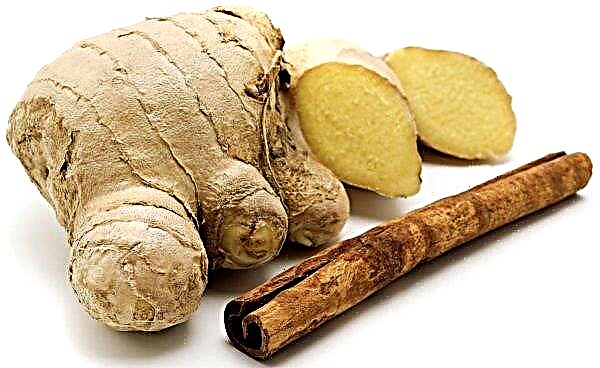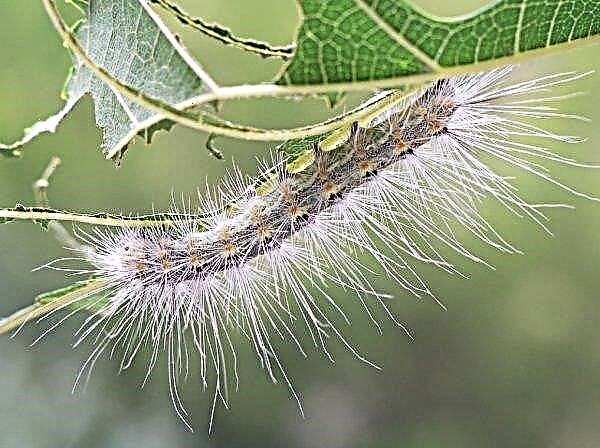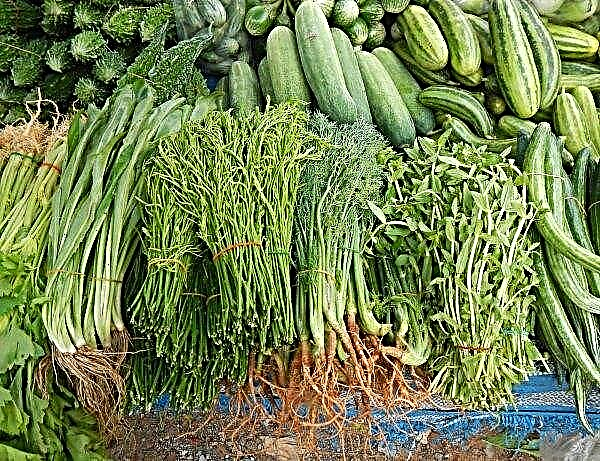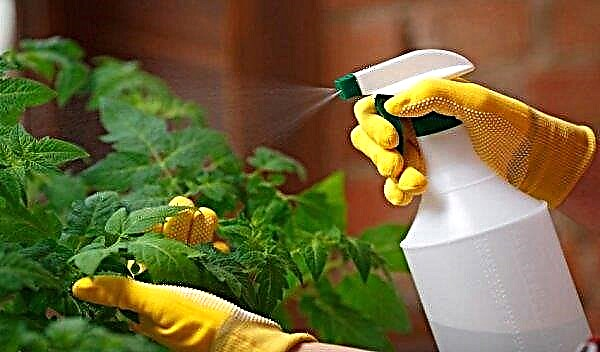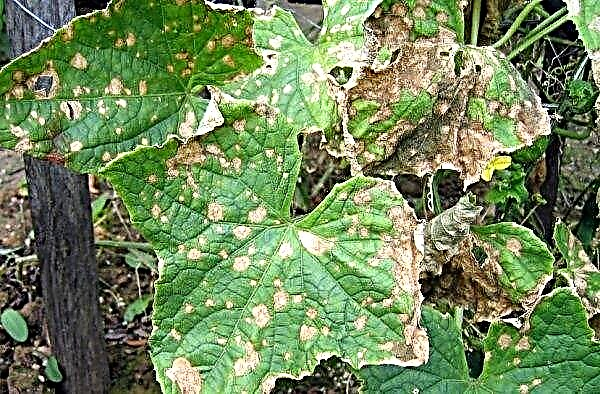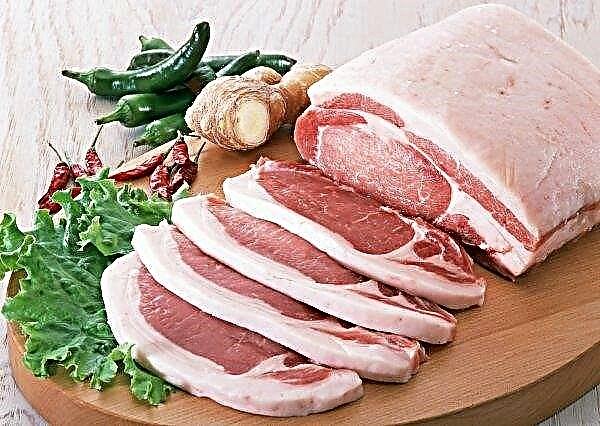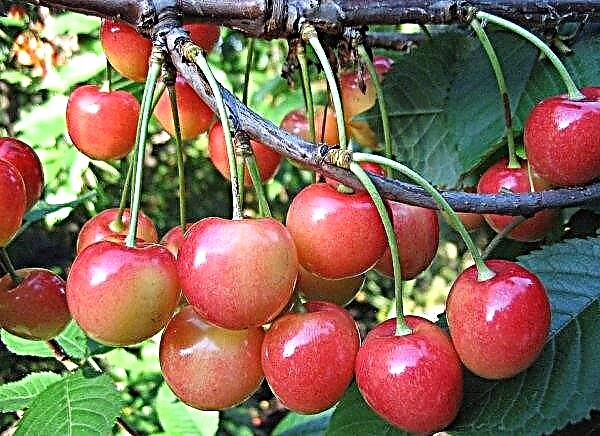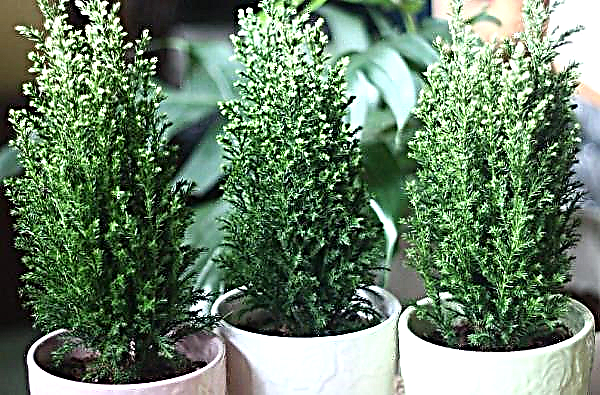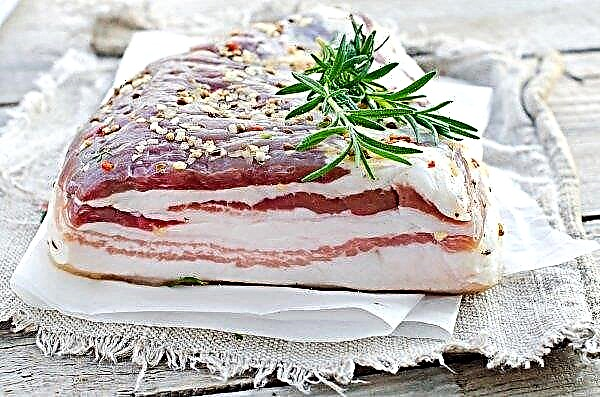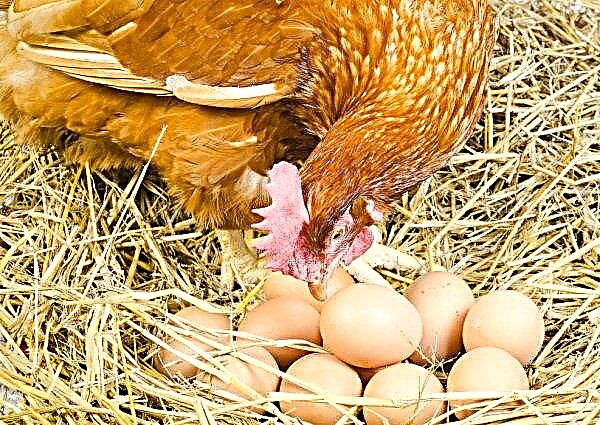The variety of Western Thuja Teddy every year more and more interested in both landscape designers and amateur gardeners. The success of the evergreen bush is due to the high decorative qualities of a long-term culture, frost resistance, unpretentiousness, longevity, the ability to purify the air with the help of allocated phytoncides. About what characteristics of the western Teddy thuja, planting rules, care features, breeding methods, how it is used in landscape design - further in the article.
Grade description
Teddy is a miniature variety of western thuja. This is a decorative evergreen undersized shrub with a spherical crown. The appearance of dense soft bushes resembles a Teddy teddy bear, so the hybrid got its name. The western Teddy (Thuja occidentalis Teddy) belongs to the Cypress family.
Did you know? Homeland of Western Thuja — North America. A long-term culture was introduced into Europe in the 40s of the XVI century.
Due to the high aesthetic qualities and unpretentiousness in care, the coniferous shrub has become very popular in landscape compositions.
According to the description, the dwarf thuja grows slowly:
- adds within 2-3 months only 2-3 cm;
- in nurseries you can find three-year-old seedlings of miniature sizes in three-liter containers: up to 15 cm;
- at the age of ten, the height of the bush does not exceed 35 cm, the diameter is 30–40 cm;
- an adult plant reaches a height of 50 cm after 20 years.

Teddy coniferous shrub is a real long-liver, its life expectancy is from 100 to 150 years. A large number of thin young growths, tightly adjacent to one another, form a dense crown of spherical shape, the width of which is several centimeters greater than the height. The shrub does not need forming pruning, which is one of the advantages of unpretentious coniferous culture.
The main characteristics of Teddy include:
- The young needles of the bush are soft needle-shaped, located densely on the shoots, and eventually turn into stiff scales.
- A green crown with a bluish tint in the fall and winter turns yellow a little or acquires a bronze color. Its renewal occurs in 2-3 years as a result of falling branches. After 25 years, the branches of the bush begin to fall apart a little.
- The bark of a perennial plant is smooth, the wood is soft, but strong.
- The root system is branched, its characteristic features: surface location and sensitivity to soil compaction, so the soil must be loosened and constantly moistened slightly.
- In small cones, covered with thin scales, there are seeds.
The Teddy variety has a temperate continental climate. Adult plants have good winter hardiness and are not afraid of short-term drought. Coniferous perennials can grow in the fifth climatic zone of frost resistance, i.e., tolerates temperatures of -26.1 ...- 28.9 ° C. It corresponds to the territory of central Russia: Bryansk, Leningrad, Voronezh and Saratov regions, St. Petersburg, Vladivostok.
The effect of dry air on coniferous shrubs is negative. But it grows well in the shade. The bush is enough just 4-5 hours a day to stay in the sun. In the southern regions, coniferous perennials can be grown only with sufficient shading or continuous drip irrigation.Did you know? Dwarf Teddy was created in the 50s of the XX century by German breeders by the method of selection of seedlings of the Kobold variety.
In landscape design
Variety Teddy thuja western is often used to decorate parks, gardens, squares, alpine slides, rockeries. It looks like a neat low evergreen ball. With the help of a long-term culture, various green compositions are created. It is used to decorate group and mixed plantings, flower beds, mixborders, the area near the gazebo, benches and sculptures in the garden. In this case, a dwarf bush should be placed in the foreground of large flower beds.
When creating artificial decorative ponds, do not forget to plant miniature shrubs in the coastal area that adore humid air. Due to their compact size and unpretentiousness, they look great as elements of a rocky, heather or Japanese garden. Variety specimens are planted along the paths, combining with bushes of roses, peonies, irises, conifers with a crown in the form of a cone with golden leaves. A combination of Teddy with juniper will look harmonious. The dwarf plant in the middle of a grassy lawn has the wonderful look as the main element of landscape composition.

Create an interesting view of the access area by planting Teddy seedlings along the curbs. Plant the seedlings in containers or special flower boxes, then place them on the terrace, roof, balcony, you can also divide the garden into zones. For the winter, containers with ornamental plants should be brought into a room with a positive temperature or well wrapped.
Important! The distance between the dwarf shrubs Teddy in a row should be no more than half a meter.
Landing
Teddy can grow on any kind of soil. Better choose a place with light and well-drained soil. On the market offer seedlings with open and closed roots (in containers). The first can be purchased cheaper, they should be planted in spring or autumn. Choose healthy specimens in pots with elastic growths, needles, without spots and yellowness on the crown and bark. Do not buy damaged bushes. They are transplanted during April-October.
In the market there are poor-quality seedlings placed in pots, although they were previously grown for sale with an open root. Their crown is elongated or crookedly formed, there are no roots and an earthen ball crumbles.
It is better to buy planting material in containers from nurseries. Such bushes can be planted throughout the warm period. Shrubs with open roots must be planted within one to two days. Calculate the planting time so that the seedling has time to take root before frost.Site selection and preparation
Characteristics of a correctly selected location for a Teddy shrub:
- well-lit or semi-shaded, protected from wind and direct sunlight;
- An elevated site or terrain with a slight slope that protects the crop from excess moisture.

Unsuitable conditions, for example, a shady place or with direct sunlight, will provoke uneven development of shoots that can form a sparse crown or, conversely, burnout of the crown on the sunny side.
Important! Increase the fertilizer rate to 8–10 g if there is no compost, humus or wood ash in the substrate.
Teddy prefers neutral or slightly acidic soil: light loam, clayey sandstone. Prepare in advance the substrate for the planting recess, which should contain sand, peat, leaf compost, garden soil in a ratio of 1: 1: 1: 2, respectively. This mixture should be saturated with complex fertilizer for conifers at the rate of: 5–7 g of product per 1 kg of soil mixture.
Step-by-step instruction
Make the bush pit spacious for free distribution of surface roots, its dimensions: 60 × 60 × 60 cm. If the soil is heavy, line the bottom of the pit with a layer of drainage from broken brick or expanded clay - 15–20 cm.
The landing technology is as follows:
- laying the prepared substrate;
- placing the seedling so that the root neck is at the level of garden soil;
- dusting with an earthen lump and compaction of the substrate;
- watering - 8-12 l;
- mulching along the perimeter of a pit filled with peat, wood bark or hay.

A day before planting, water the plant abundantly in a container so that you can then easily get it along with the soil.
Care Features
Teddy bush maintenance, which should include timely watering, annual top dressing, pruning of dry branches, treatment of the root circle of the soil by weeding and loosening, which facilitates the penetration of oxygen to the roots, and covering the teddy ball for the winter, will provide the coniferous plant with full growth and development.
Watering and fertilizer
The needles of the bush evaporate a lot of moisture, so organize regular and plentiful watering. An ideal condition for the Teddy variety is loose and moderately moist soil near the plant. Water consumption for shrubs is 10 liters per week. In hot weather should be watered more often, as well as conduct evening sprinkling (spraying the crown with water) twice or thrice a week. Irrigation of needles will provide the dwarf variety with a bright, juicy color of needles and a fresh smell. The lack of water will affect the appearance of the undersized coniferous representative: the crown will begin to turn yellow and thin.
To seedlings took root, water it as the soil dries and loosen the soil to a shallow depth. If you planted a bush in hot weather, increase the frequency of watering. Basal mulching also allows you to save moisture from evaporation. In the spring, when the plants wake up, they recommend moistening the trunk circle more.
Feed the Teddy shrub once a year with the quick-digesting and low-toxic Nutrisol softwood complex, which contains minerals: phosphorus, potassium, iron, zinc, magnesium, manganese. Apply fertilizer dissolved in water at the beginning of spring at the rate of: 60 g per plant.Important! After spring fertilizer, the thawed Teddy should be watered with 15 liters of water twice a week, with a lack of rain.

If you prefer to fertilize nitroammophos (based on nitrogen, phosphorus and potassium) in an amount of 30–40 g per 1 m², it is necessary to additionally fertilize in September, and then moisten the soil well. To improve the nutrition of the bush when loosening the soil, feed it with vegetable compost or peat. Overfeeding the soil can cause the crown to lose its shape as the growth rate increases.
Soil cultivation and mulching
To preserve moisture, reduce the frequency of watering and prevent the growth of weeds, mulch the trunk circle of the Teddy shrub using peat, compost, sawdust, wood bark, dry grass or other material. If you do not carry out this procedure, then it is imperative to loosen the soil after each watering. Consider the close location of the root processes and act with great care.
Trimming and Shaping
The Teddy variety forms a spherical crown as it grows, so there is no need for shaping pruning. In early spring, annual sanitary pruning is performed, while damaged, dry and elongated branches are removed. This haircut is called topiary. For the first time, they are engaged in this process upon reaching the age of two of a young seedling.
Important! When sanitary pruning is not recommended to remove more than 30% of young growths. After some time, part of the inner needles will crumble, and the needles will grow densely along the entire perimeter of the crown.
Shelter for the winter
Teddy seedlings cover for the winter the first three years of life with natural materials, burlap. Frosts are not afraid of adult bushes. Strong snowstorms can damage the crown, therefore a young plant is associated with an unformed crown in the autumn. Wet snow is removed from the branches.
For adult Teddy representatives, it is better to equip a round or pyramidal wooden frame or grid arch, top cover with spruce branches or cut branches. Sprinkle the soil near the trunk with polystyrene and straw, after removing the mulch. In February, cover the crown with agrofiber to avoid sunburn.
Disease and Pest Prevention
Dwarf Teddy is rarely attacked by pests, it is resistant to disease. However, this coniferous plant is vulnerable to fungal diseases, for example, to fusarium, brown shute, cytosporosis. At the first symptoms, the bush should be treated with one of the fungicides that contain copper: “Topsin-M”, “Hom”, “Maxim”, “Horus”, “Quadris”. For preventive purposes, they use the systemic drug Fundazol. To prevent fungal infections in April, the shrub should be treated with a Bordeaux mixture.
From the soft green needles of Teddy thuja, they can suck aphid juice, a pseudoscutum, and also a spider mite. To get rid of insects, perennial must be treated with one of the insecticides: “Aktara”, “Decis”, “Confodor”, “Angio”. After 7-10 days, re-spray. Destroy ticks using any of acaricides: Apollo, Omayt, Flumayt. You can use insectoacaricides: Agravertin, Akarin, Kleschevit, Fitoverm.
Breeding methods
The Teddy variety can be propagated using the vegetative (cuttings) and generative (seed) method. Cuttings make it possible to preserve all the signs of a coniferous perennial. This method is simple and effective. Generative propagation does not guarantee the preservation of varietal traits of a dwarf plant; it is a painstaking process that lasts for 5–6 years. The advantage of this method is a good adaptation of the shrub to local growing conditions. Experienced gardeners use the more time-consuming Sharimiki technique. It consists in dividing the bush by part or rooting with the help of horizontal layering.
Did you know? American Indians made from thuja leaves a medicine for headaches and for the prevention of scurvy. The effectiveness of such a remedy is explained by the presence of a large amount of vitamin C in the needles.
Cuttings
The material for vegetative propagation is semi-lignified one- and two-year-old straight healthy shoots from the middle of the bush, 20-30 cm long. Viable cuttings with a small piece of bark are also used, for this you should grasp the branch tightly and pull strongly. A little old wood, rich in nutrients, will allow the cuttings to take root.
In doing so, adhere to the following instructions:
- Harvesting of annual shoots is carried out at the beginning of the summer period, and of two-year shoots in the autumn. The prepared “segments” should be cleaned of needles in the lower part, and the section should be soaked in a solution that stimulates growth, for example, use “Heteroauxin”. Such manipulation will accelerate the formation of root processes.
- Then you need to prepare the soil mixture. To do this, take equal parts of peat, sand and garden soil. Disinfect the soil mixture by calcining in the oven. In the container with the prepared substrate, place the treated shoots to a depth of 2-4 cm, tilting them at an angle of 75 °.
- The container should be left in a room with a temperature of +22 ... + 23 ° С and humidity of 70%. Next, you need to regularly water, ventilate and gradually harden the cuttings. These manipulations will ensure the successful cultivation of seedlings.
- After rooting the cuttings, plant them in separate pots to further grow.
- In late autumn, sprinkle the soil near the seedling with mulch from peat and cover it with spruce top.

Seed cultivation
For future sowing, ripened seeds are harvested in autumn. To do this, pick cones and leave them in a warm room. After some time, they will open and release the seed material. Then produce its stratification (exposure to low temperatures) in the refrigerator for 2-3 months.
In the spring, the following manipulations are performed:
- In March, cooled Teddy thuja seeds are sown in containers with prepared substrate. To prepare the soil mixture, take turf soil, peat and sand in a ratio of 1: 2: 0.5, then watered with a weak manganese solution in order to disinfect the soil and destroy pests.
- Place the seeds in a substrate to a depth of 5 mm, sprinkle a thin layer of sand on top.
- After sowing, the soil is moistened with a spray gun and the container is covered with glass or film to create a greenhouse effect.
- Further, germinating seeds are periodically watered and aerated.
- The grown seedlings are planted in open ground, rich in nutrients, it is desirable to choose a place in partial shade.

According to gardeners, cultivating the western Teddy Thuja is uncomplicated. The compact size and symmetrical, neat shape of the plant allow them to decorate any area. They note the high frost resistance of the plant, but pay attention to the need to protect the shrub from snow so that it does not fall apart in winter. To do this, it is recommended to install frames or grids over it. With the right choice of place, the crown does not fade and forms a plush ball.
Thuja Teddy - a beautiful and spectacular decorative bush. The advantages of a perennial culture allow you to grow it on your site for decades. Teddy is often used by designers to create original landscape compositions. A dwarf plant can be planted in open ground, as well as in pots, decorating terraces and gazebos.Did you know? German scientists in 2002 reported that extracts based on leaves of thuja, alcohol and water have antiviral, anti-inflammatory and bactericidal effects, as well as inhibit the reproduction of type A influenza virus.

Even a beginner gardener can plant, grow, care for and even propagate an evergreen coniferous compact plant. Thuja Teddy is resistant to diseases and pests and independently forms a crown shape. Ornamental shrubs transform the park, square, garden, green lawn, flower garden. The look of fabulous plush balls with its softness and restraint always surprises and attracts attention.

